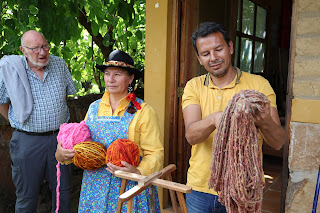Granja El Recreo, also known as Finca Ecoturística El Recreo, is a sustainable
farm nestled in the Sabana district of Villa de Leyva, Colombia. It’s a haven
for eco-conscious travelers, artists, and volunteers looking to connect with
nature and learn hands-on skills in permaculture, organic and biodynamic
farming, and bioconstruction techniques like adobe, bamboo, and maguey.
The farm spans about 4 to 8 hectares and offers a rustic yet welcoming setup:
shared rooms, a dry toilet, communal kitchen, Wi-Fi, and even space for
camping. Visitors can get involved in everything from gardening and carpentry
to artistic projects like land art. It’s not just a place to stay—it’s a place
to grow, both literally and personally.
They also host wool workshops and cultural experiences, including traditional
games like Tejo, giving guests a taste of local heritage alongside the natural
beauty of the Valle Escondido nearby.
|
Entrance to El Recreo Ecotourism Farm
|
|
The team of workers greets visitors
|
|
The table for lunch is set on the balcony
|
|
Soup, main course and drink
|
|
Traditional hand shearing of a sheep
At places like Granja
El Recreo, just outside Villa de Leyva, visitors can witness—and even
participate in—this age-old practice.
-
The process begins with gently restraining the sheep, often by tying
its legs, and then using large sewing scissors to carefully shear the
wool by hand. This method, though slower than machine shearing, is
considered more respectful and less stressful for the animal.
-
Once the wool is removed, it’s traditionally stored for 48 hours
before further processing. This pause is rooted in a local belief that
immediate use of freshly shorn wool could harm the sheep, possibly due
to exposure to cold.
-
After this period, the wool is cleaned, hand-dyed with natural
pigments, and spun into yarn using manual looms. These techniques are
passed down through generations and are central to the identity of
local weaving cooperatives.
-
Experiencing this firsthand offers a glimpse into the resilience and
creativity of Colombia’s rural communities.
|
|
Carding and spinning wool
In the Villa de Leyva region of
Colombia, carding and spinning wool are cherished artisanal practices
that preserve centuries-old traditions. At places like Granja El Recreo,
visitors can engage directly with these processes as part of immersive
workshops that celebrate the region’s rural heritage2.
-
Carding is the first step after shearing and resting the wool. It
involves brushing the raw fibers with hand carders—flat paddles
covered in fine wire teeth—to align them and remove debris. This
creates soft, fluffy rolls called rolags, which are ideal for
spinning.
-
Spinning follows, where the carded wool is twisted into yarn using a
spindle or spinning wheel. At El Recreo, this is often done manually,
allowing participants to feel the rhythm and texture of the fiber as
it transforms. The yarn is then used in weaving or knitting, often
dyed with natural pigments sourced from local plants.
-
These workshops aren’t just about technique—they’re about
storytelling. The women leading them are part of a cultural rescue
project, passing down knowledge that might otherwise be lost. And the
wool they produce? It’s not just for sale in local shops—it’s even
made its way onto fashion runways across Colombia.
|
|
Weaving wool
Weaving wool on a loom in the Villa de Leyva
region is a beautiful expression of Colombia’s rural artistry—where
tradition, patience, and creativity intertwine.
-
At places like Granja El Recreo, just outside Villa de Leyva, visitors
can witness the full journey of wool: from hand-shearing sheep to
spinning yarn, and finally to weaving it into textiles using manual
looms. The looms themselves are often rustic and handmade, passed down
through generations. Women from the local community, many of whom are
part of a cultural rescue initiative, guide the process with practiced
hands and deep pride.
-
The weaving techniques vary—from simple plain weaves to more intricate
patterns—and the wool is often dyed with natural pigments sourced from
local plants. The resulting textiles are used to make scarves,
ponchos, bags, and decorative pieces, many of which are sold in Villa
de Leyva’s artisan markets or even showcased on Colombian fashion
runways.
-
Participating in a weaving workshop here isn’t just about learning a
skill—it’s about connecting with a way of life that values
sustainability, storytelling, and ancestral knowledge.
|
|
Playing the Tejo
Tejo has deep roots in the country’s
indigenous history, particularly among the Muisca people of the Boyacá
region, where Villa de Leyva is located.
-
The modern version of the game is played by hurling a heavy metal puck
(called a tejo) toward a clay-filled board set at an angle.
-
Embedded in the clay are small triangular packets of gunpowder called
mechas. When struck just right, they explode with a loud bang—earning
cheers, points, and maybe a round of beers.
-
The game is both competitive and social. Points are awarded for
accuracy, proximity to the center, and of course, for triggering those
satisfying explosions.
-
It’s often played in open-air halls or rustic bars, and Villa de Leyva
has a few spots where locals and visitors alike gather to play.
-
If you’re up for a mix of history, adrenaline, and community spirit,
trying Tejo in Villa de Leyva is a must.
|
See Also
Source
Location
Raquira
Convent of the Holy Ecce Homo
Monquira Archaeological Park
El Fosil Community Museum
Villa de Leyva



































